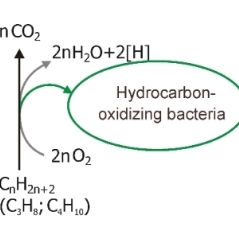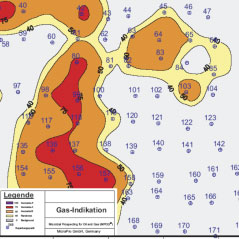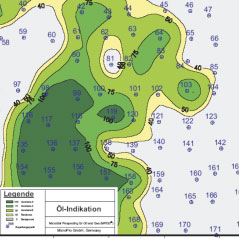Basis of Microbial Prospecting for Oil and Gas
The basis of MPOG® is that oil or gas fields emit a continuous stream of light hydrocarbon gases to the earth's surface known as macro- and micro-seepages.
In all shallow soil and sediment layers a variety of specialized micro-organisms (hydrocarbon oxidizing bacteria) exists, able to utilize extremely low concentrations of short-chain hydrocarbons (10-6 %vol/vol). Based on a continuous hydrocarbon supply active populations of hydrocarbon degrading bacteria can develop. This long term supply is almost exclusively found at micro-seepages above hydrocarbon bearing structures. Under these conditions detectable populations of bacteria develop with significantly increased cell numbers and a high biochemical activity.
For oil and gas exploration two well distinguishable groups of bacteria are relevant:
- Hydrocarbon oxidizing bacteria
- Methane oxidizing bacteria (Methylotrophic)
Due to high specialization of methane-oxidizing bacteria, the MPOG® method allows methane-oxidizers to be isolated from all other bacteria and biochemically analyzed. A significantly increased activity and cell number of methane oxidizing bacteria represents an indication for methane occurrence in soil samples.
Another biochemical group of microorganisms uses short-chained hydrocarbons (C2 - C8) as energy source. These micro-organisms are not able to metabolize methane. Short alkanes namely ethane, propane and butane can be utilized by a large variety of bacteria. Detection of active bacteria which oxidize n-alkanes with chain lengths of 2 to 8 carbon atoms without any adaptation period indicates the existence of oil signatures in the area investigated.
On the basis of a complex microbiological test scheme to determine bacterial count and biochemical activity of specific bacteria, an oil and gas indication factor will be recorded for each soil or sediment sample. Maps with identified microbial hydrocarbon anomalies show position and extent of hydrocarbon indications.
The higher the calculated measure units (cell numbers and activity), the more intense the hydrocarbon supplies to bacteria and the greater the probability of finding hydrocarbon accumulations at these positions.
MPOG® data can easily be integrated into existing exploration data sets (e.g. seismic) or used for pre-selection of particularly interesting areas for subsequent, cost-intensive exploration techniques (wild-cat exploration).



